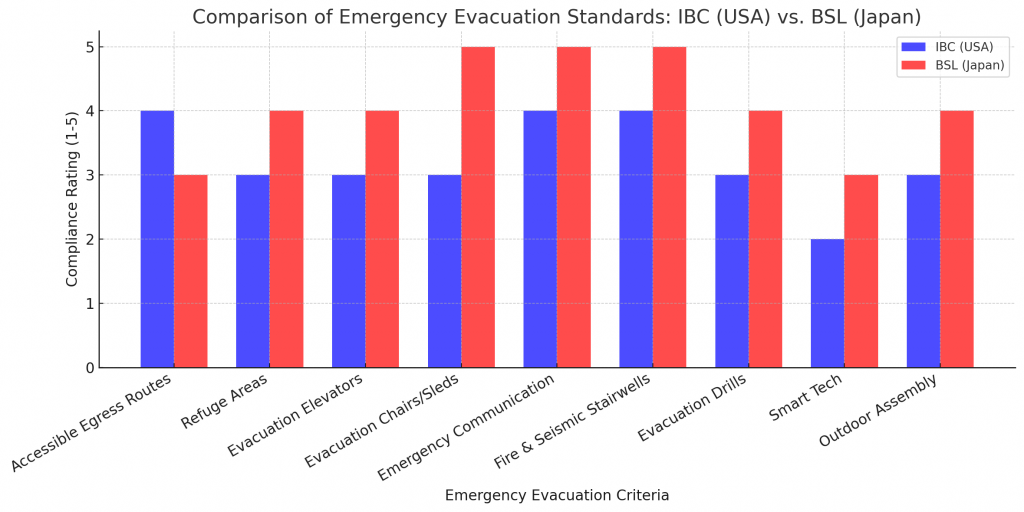
Comparison of Emergency Evacuation Standards for Disabled Persons: IBC (USA) vs. BSL (Japan)
| Category | IBC (USA) | BSL (Japan) |
| Scope & Application | Applies to all public buildings, assembly occupancies, high-rises, and facilities with mobility-impaired occupants. | Applies to public buildings under Japan’s Barrier-Free Law and disaster management regulations. |
| Accessible Means of Egress | Requires at least two accessible egress routes per IBC 1009.2. | Requires at least one accessible evacuation route in public-use buildings. |
| Areas of Refuge (Refuge Spaces) | Required in multi-story buildings unless an accessible exit is provided (IBC 1009.6). | Similar refuge areas required for large buildings, often linked to fireproof areas. |
| Stairway Evacuation for Wheelchair Users | Evacuation chairs or assistance required where elevators cannot be used (IBC 1009.8). | Evacuation sleds or lifts often required, with trained staff assistance in public buildings. |
| Use of Elevators During Emergency | Permitted only for fire service-accessible elevators or specifically designed occupant evacuation elevators (IBC 3008). | Similar, but Japan emphasizes earthquake-resistant elevators for emergency evacuation. |
| Fire-Resistant Egress Routes | Minimum 1-hour fire-rated enclosures for accessible stairwells (IBC Table 1023.2). | Requires fireproof stairwells with a minimum 2-hour fire resistance in high-rise buildings. |
| Emergency Communication & Signage | Two-way emergency communication required in Areas of Refuge (IBC 1009.8.1). | Emergency call buttons and voice guidance required in accessible refuge areas. |
| Training & Drills | Fire evacuation plans must incorporate disabled persons (IBC 403.4.7). | Japan’s Disaster Countermeasure Act mandates evacuation assistance plans for disabled individuals. |
| Alternative Evacuation Devices | Evacuation chairs, lifts, or sleds are recommended but not always required. | Mandatory evacuation devices for multi-story buildings with high occupancy. |
| Seismic Considerations | Not a primary focus, but buildings must comply with seismic safety codes. | Stronger emphasis on earthquake evacuation, including automatic safety stop elevators. |
Key Differences:
- IBC requires Areas of Refuge in multi-story buildings where an accessible egress route is unavailable, while BSL often integrates these with fireproof spaces.
- Japan mandates earthquake-resistant evacuation measures, while IBC focuses on fire safety and stair-assisted evacuation.
- Evacuation devices (sleds, chairs, lifts) are more commonly mandatory in Japan than in the U.S.
- Training for disabled evacuation is explicitly part of Japan’s disaster preparedness laws, whereas IBC requires integration into fire safety plans.
Recommendations for Emergency Evacuation for Disabled Persons
For IBC (USA):
- Increase the Number of Accessible Egress Routes – Require at least two fully accessible exits in all multi-story buildings.
- Expand Areas of Refuge – Enforce larger, well-equipped refuge spaces with proper ventilation, communication, and fireproofing.
- Integrate Seismic-Resistant Evacuation Elevators – Encourage fire and earthquake-resistant elevators with emergency backup power.
- Mandate Evacuation Chairs in High-Rise Buildings – Require at least one evacuation chair per stairwell for safe assisted evacuation.
- Improve Emergency Communication – Standardize haptic feedback, visual signals, and multilingual guidance in emergency systems.
- Strengthen Fire-Rated Stairwells – Upgrade fireproof stairwells to meet seismic-resistant standards for increased safety.
- Require Inclusive Evacuation Drills – Enforce annual emergency drills that include assistance for disabled persons.
- Introduce Smart Evacuation Technology – Develop real-time tracking systems to alert emergency responders to disabled occupants’ locations.
- Enhance Outdoor Assembly Accessibility – Ensure accessible gathering points with clear signage, seating, and emergency call stations.
- These updates will improve compliance with accessibility and life safety standards in high-rise buildings, stadiums, and public venues.
For BSL (Japan):
- Increase the Number of Accessible Egress Routes – Require at least two emergency exits for disabled persons in multi-story public buildings.
- Standardize Fireproof Refuge Areas – Establish well-defined refuge spaces with fireproofing, communication systems, and emergency lighting.
- Enhance Seismic-Resistant Elevators – Require earthquake-resistant evacuation elevators in all high-rise and public buildings.
- Mandate Evacuation Sleds in All Multi-Story Buildings – Ensure every stairwell has a designated evacuation sled for safe assisted evacuation.
- Strengthen Emergency Communication Systems – Improve audible guidance, braille/tactile signage, and emergency call buttons.
- Reinforce Fireproof & Earthquake-Resistant Stairwells – Implement mandatory seismic upgrades for all emergency stair enclosures.
- Expand Nationwide Disaster Preparedness Training – Mandate annual inclusive emergency drills focused on assisting disabled evacuees.
- Adopt Smart Evacuation Technology – Utilize tracking apps and emergency locator systems for rapid assistance during disasters.
- Improve Outdoor Evacuation Areas – Designate accessible outdoor assembly zones with seating, shade, and emergency communication tools.
- By implementing these changes, Japan’s Barrier-Free Law and Disaster Countermeasure Act can provide safer, more inclusive evacuation options in both fire and earthquake emergencies
